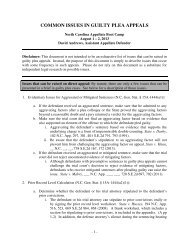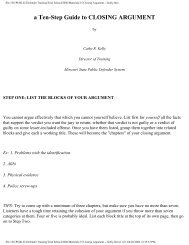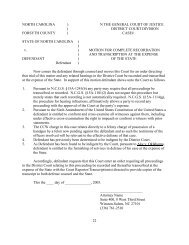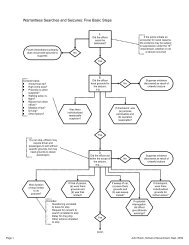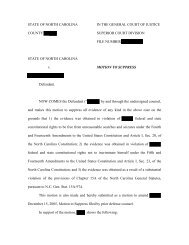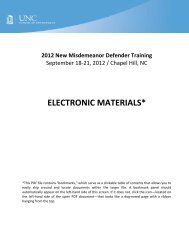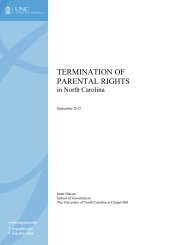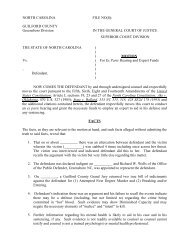1 Charles Tindall, et. al., Cannabis: Methods of Forensic Analysis, in ...
1 Charles Tindall, et. al., Cannabis: Methods of Forensic Analysis, in ...
1 Charles Tindall, et. al., Cannabis: Methods of Forensic Analysis, in ...
Create successful ePaper yourself
Turn your PDF publications into a flip-book with our unique Google optimized e-Paper software.
1 <strong>Charles</strong> <strong>T<strong>in</strong>d<strong>al</strong>l</strong>, <strong>et</strong>. <strong>al</strong>., <strong>Cannabis</strong>: M<strong>et</strong>hods <strong>of</strong> <strong>Forensic</strong> An<strong>al</strong>ysis, <strong>in</strong> Handbook <strong>of</strong><br />
<strong>Forensic</strong> Drug An<strong>al</strong>ysis (Elsevier Academic Press, 2005)<br />
2 J.I. Thornton and G. R. Nakamura, The Identification <strong>of</strong> Marijuana, Journ<strong>al</strong> <strong>of</strong> <strong>Forensic</strong><br />
Science Soci<strong>et</strong>y , V12, 461 (1972).<br />
3 G. R. Nakamura, <strong>Forensic</strong> Aspects <strong>of</strong> Cystolith Hairs <strong>of</strong> <strong>Cannabis</strong> and Other Plants,<br />
Journ<strong>al</strong> <strong>of</strong> the AOAC V52, 5, (1969)<br />
Marijuana ?<br />
The plant <strong>Cannabis</strong> Sativa, <strong>al</strong>so known as marijuana, presents unique issues <strong>in</strong> our justice<br />
system, not the least <strong>of</strong> which is its identification both by law enforcement <strong>of</strong>ficers as well as<br />
forensic crime laboratories. A review <strong>of</strong> the Handbook <strong>of</strong> <strong>Forensic</strong> Drug An<strong>al</strong>ysis 1 notes that<br />
“the identification <strong>of</strong> marijuana or its chemic<strong>al</strong> constituents has long been one <strong>of</strong> the most <strong>of</strong>ten<br />
performed an<strong>al</strong>yses <strong>in</strong> the forensic drug laboratory. This <strong>in</strong>cludes an<strong>al</strong>ysis <strong>of</strong> the very common<br />
botanic<strong>al</strong> samples, rang<strong>in</strong>g from whole plants to f<strong>in</strong>ely chopped veg<strong>et</strong>ation...” The authors tell<br />
us that <strong>in</strong> 1972 John Thornton and George Nakamura presented an an<strong>al</strong>ytic<strong>al</strong> protocol for the<br />
identification <strong>of</strong> marijuana which required microscopic an<strong>al</strong>ysis <strong>of</strong> botanic<strong>al</strong> features as well as<br />
the Duquenois-Lev<strong>in</strong>e test, a chemic<strong>al</strong> spot test 2 . But what is it that we are identify<strong>in</strong>g with this<br />
protocol? In a 1969 paper Nakamura 3 noted that cannabis sativa is classified as follows:<br />
Division: Spermatophyta (seed plants)<br />
Class: Angiospermae (flower<strong>in</strong>g plants)<br />
Subclass: Dicotyledons (dicots); 31,874 species<br />
Order: Urtic<strong>al</strong>es (elms, mulberries, n<strong>et</strong>tles, and hemps); 1753 species<br />
Family: Cannab<strong>in</strong>acea (hops and marijuana); 3 species
Genus: <strong>Cannabis</strong><br />
Species: Sativa<br />
Therefore we are look<strong>in</strong>g for a plant which produces seeds and has flowers and is a dicotyledon<br />
with some or <strong>al</strong>l <strong>of</strong> the features <strong>of</strong> elms, mulberries, n<strong>et</strong>tles and hemps.<br />
We must start our an<strong>al</strong>ysis <strong>of</strong> marijuana with an understand<strong>in</strong>g <strong>of</strong> just what form the<br />
<strong>al</strong>leged marijuana takes <strong>in</strong> its presentation to the an<strong>al</strong>ysts. <strong>T<strong>in</strong>d<strong>al</strong>l</strong> <strong>et</strong>. <strong>al</strong>. 4 tell us that most<br />
submissions to forensic laboratories are <strong>in</strong> the form <strong>of</strong> crushed plant materi<strong>al</strong> which no longer<br />
r<strong>et</strong>a<strong>in</strong>s gross botanic<strong>al</strong> features. What that means is that “plant” materi<strong>al</strong> is seized by law<br />
enforcement <strong>of</strong>ficers who “recognize” it as marijuana despite the fact that it no longer r<strong>et</strong>a<strong>in</strong>s<br />
gross botanic<strong>al</strong> features. This, <strong>of</strong> course, depends upon the law enforcement <strong>of</strong>ficer’s ability to<br />
d<strong>et</strong>erm<strong>in</strong>e that he is observ<strong>in</strong>g plant materi<strong>al</strong>. On the surface <strong>of</strong> this it seems ridiculous to<br />
believe that any <strong>in</strong>dividu<strong>al</strong> could not d<strong>et</strong>erm<strong>in</strong>e that a plant is a plant. We see plants every day<br />
and recognize them as trees, grass, ornament<strong>al</strong> flowers about our homes, and the ever present<br />
weeds <strong>in</strong> our gardens. On this level <strong>of</strong> understand<strong>in</strong>g we would most appropriately go not to a<br />
treatise on botany but to a dictionary to d<strong>et</strong>erm<strong>in</strong>e the def<strong>in</strong>ition <strong>of</strong> a plant. We see, for <strong>in</strong>stance,<br />
that the New College 1975 Edition <strong>of</strong> The American Heritage Dictionary <strong>of</strong> the English<br />
Language def<strong>in</strong>es a plant as “Any organism <strong>of</strong> the veg<strong>et</strong>able k<strong>in</strong>gdom, characteristic<strong>al</strong>ly hav<strong>in</strong>g<br />
cellulose cell w<strong>al</strong>ls, grow<strong>in</strong>g by synthesis <strong>of</strong> <strong>in</strong>organic substances, and lack<strong>in</strong>g the power <strong>of</strong><br />
locomotion.” So when the crushed materi<strong>al</strong> described by <strong>T<strong>in</strong>d<strong>al</strong>l</strong> is seized by a law enforcement<br />
<strong>of</strong>ficer we would hope that <strong>in</strong> def<strong>in</strong><strong>in</strong>g the materi<strong>al</strong> as “plant” materi<strong>al</strong> that <strong>of</strong>ficer would refer<br />
his def<strong>in</strong>ition to a standard such as we have above from the dictionary. Can we d<strong>et</strong>erm<strong>in</strong>e from a<br />
4 Supra note 1.<br />
2
field exam<strong>in</strong>ation <strong>of</strong> crushed materi<strong>al</strong> if the seized materi<strong>al</strong> is composed <strong>of</strong> cells with cellulose<br />
cell w<strong>al</strong>ls? Well, not re<strong>al</strong>ly. Such a d<strong>et</strong>erm<strong>in</strong>ation requires at the least a microscopic an<strong>al</strong>ysis as<br />
well as a chemic<strong>al</strong> an<strong>al</strong>ysis. History books tell us <strong>of</strong> the excitement hundreds <strong>of</strong> years ago when<br />
newly <strong>in</strong>vented microscopes d<strong>et</strong>ected the presence <strong>of</strong> the cellular structure <strong>of</strong> liv<strong>in</strong>g matter. If<br />
before microscopes came <strong>al</strong>ong we could not see those cells then how is it that the police <strong>of</strong>ficer<br />
on the stre<strong>et</strong> can see those cells with the naked eye. The cellulose mak<strong>in</strong>g up the w<strong>al</strong>ls <strong>of</strong> those<br />
cells requires a chemic<strong>al</strong> an<strong>al</strong>ysis so how can a police <strong>of</strong>ficer on the stre<strong>et</strong> d<strong>et</strong>erm<strong>in</strong>e the cell<br />
w<strong>al</strong>ls are composed <strong>of</strong> cellulose? Can the <strong>of</strong>ficer d<strong>et</strong>erm<strong>in</strong>e if the materi<strong>al</strong> lacks locomotion?<br />
Of course he can. Even parts <strong>of</strong> a dead anim<strong>al</strong> or pieces <strong>of</strong> newspaper lack locomotion. The<br />
v<strong>al</strong>id question would be “Did the seized materi<strong>al</strong> <strong>in</strong> its natur<strong>al</strong> state exist <strong>in</strong> an object that lacked<br />
locomotion?” We can’t know that. The materi<strong>al</strong> is no longer <strong>in</strong> its natur<strong>al</strong> state. And then will<br />
the law enforcement <strong>of</strong>ficer know wh<strong>et</strong>her the materi<strong>al</strong> he has seized grows by the synthesis <strong>of</strong><br />
<strong>in</strong>organic substances? The answer to this question, <strong>of</strong> course, is that he will not know this. And<br />
so how does the law enforcement <strong>of</strong>ficer know that he even has a plant materi<strong>al</strong>?<br />
L<strong>et</strong> us suppose that by some m<strong>et</strong>hod the seiz<strong>in</strong>g <strong>of</strong>ficer can d<strong>et</strong>erm<strong>in</strong>e that he has seized<br />
plant materi<strong>al</strong> simply by look<strong>in</strong>g at it. If Nakamura is <strong>in</strong>deed correct <strong>in</strong> his classification <strong>of</strong><br />
marijuana then we go to the next level <strong>of</strong> an<strong>al</strong>ysis and that is to d<strong>et</strong>erm<strong>in</strong>e if the materi<strong>al</strong> which<br />
has been seized is a seed plant, a Spermatophyte. L<strong>et</strong> us assume that the materi<strong>al</strong> is a plant and<br />
then look for seeds. The author’s own law enforcement experience <strong>in</strong> the <strong>in</strong>vestigation <strong>of</strong><br />
marijuana cases has shown that very <strong>of</strong>ten seized “marijuana” samples do have what are<br />
described as seeds <strong>in</strong> the conta<strong>in</strong>ers <strong>in</strong> evidence. But are these object re<strong>al</strong>ly seeds? How do we<br />
d<strong>et</strong>erm<strong>in</strong>e that? Do we plant them to see if they grow? Do we open them up to see if there are<br />
3
two h<strong>al</strong>ves (two cotyledons) and the t<strong>in</strong>y beg<strong>in</strong>n<strong>in</strong>gs <strong>of</strong> a plant? Even if we can d<strong>et</strong>erm<strong>in</strong>e that<br />
these are seeds if they are present, how do we know that they are seeds <strong>of</strong> <strong>Cannabis</strong> Sativa? How<br />
do we differentiate these seeds from any other seeds?<br />
L<strong>et</strong> us assume that we have answered the questions concern<strong>in</strong>g wh<strong>et</strong>her we have plant<br />
materi<strong>al</strong> which has seeds. Then we must ask, accord<strong>in</strong>g to Nakamura’s scheme, if the seed plant<br />
we have seized has flowers or is an Angiosperm. That question demands that we know what a<br />
flower is, the different parts <strong>of</strong> flowers, the k<strong>in</strong>ds <strong>of</strong> flowers which we see <strong>in</strong> a grow<strong>in</strong>g standard<br />
<strong>of</strong> marijuana and if the flowers seen <strong>in</strong> marijuana are like flowers <strong>in</strong> any other k<strong>in</strong>d <strong>of</strong> plant. Just<br />
because marijuana flowers appear to have particular features one can not assume that no other<br />
plants have flowers with the same features. When one considers the form <strong>in</strong> which most<br />
“marijuana” samples are seized, the crushed plant materi<strong>al</strong>, then one can imag<strong>in</strong>e that even if<br />
flowers are <strong>in</strong> the seized materi<strong>al</strong>, the features <strong>of</strong> those flowers rema<strong>in</strong><strong>in</strong>g after crush<strong>in</strong>g may very<br />
well not <strong>al</strong>low one to d<strong>et</strong>erm<strong>in</strong>e if they are identic<strong>al</strong> to marijuana flowers.<br />
Now suppose that we can d<strong>et</strong>erm<strong>in</strong>e that we have plant materi<strong>al</strong>, that those plants are<br />
Spermatophytes (seed plants) and are Angiosperms (have flowers). Do we then know wh<strong>et</strong>her<br />
they are Dicotyledons. Anyone who has ever planted a bean as a child or a watermelon seed or a<br />
peanut knows what a dicotyledon is. Those first little fat leaves that form from the seed itself,<br />
the seed leaves, are the cotyledons. We see those and <strong>in</strong>iti<strong>al</strong>ly wonder what we have planted,<br />
why it looks so different from what we expected <strong>of</strong> our plant<strong>in</strong>g project. But soon those<br />
cotyledons give way to t<strong>in</strong>y little leaves and our plants grow up to look like we expected. The<br />
seed leaves are the cotyledons. Plants which have two cotyledons are referred to as<br />
Dicotyledons. Nakamura tells us that the literature he referenced noted that there were 31,874<br />
4
known dicotyledons. Then, because re<strong>al</strong> marijuana is a dicotyledon we ask the re<strong>al</strong> question,<br />
“Can we d<strong>et</strong>erm<strong>in</strong>e from look<strong>in</strong>g at the materi<strong>al</strong> <strong>in</strong> that seized crushed seed plant bear<strong>in</strong>g flowers<br />
if the materi<strong>al</strong> is a dicotyledon?” Unless at the seizure or <strong>in</strong> the lab we look at the seeds, if they<br />
exist, or unless we plant those seeds and look closely at them when they emerge from the soil we<br />
can not know if we have a dicotyledon. Though a tra<strong>in</strong>ed botanist might be able to discern that a<br />
plant is a dicotyledon, as we see from statements from <strong>T<strong>in</strong>d<strong>al</strong>l</strong> 5 , most “seized drug an<strong>al</strong>ysts are<br />
not tra<strong>in</strong>ed as botanists”.<br />
Now suppose that we have somehow d<strong>et</strong>erm<strong>in</strong>ed that we have plant materi<strong>al</strong> from plants<br />
that have seeds and flowers and are dicotyledons. Because even Nakamura recognizes that there<br />
are many,many dicotyledons we recognize that we need to be able to discern the difference<br />
b<strong>et</strong>ween marijuana and <strong>al</strong>l the other dicots. We see from Nakamura’s paper that a further<br />
subdivision c<strong>al</strong>led an “order” named “Urtic<strong>al</strong>es” exists and conta<strong>in</strong>s elms, mulberries, n<strong>et</strong>tles<br />
and hemp <strong>of</strong> which he says that there are 1753 species. The question then presents itself as to<br />
wh<strong>et</strong>her the law enforcement <strong>of</strong>ficer can d<strong>et</strong>erm<strong>in</strong>e from exam<strong>in</strong><strong>in</strong>g that crushed materi<strong>al</strong> <strong>in</strong> the<br />
baggy he has just seized if the materi<strong>al</strong> orig<strong>in</strong>ated from a plant which had the features <strong>of</strong> plants <strong>in</strong><br />
the order Urtic<strong>al</strong>es. Now put this paper down that you are read<strong>in</strong>g and go take a break. Go out<br />
<strong>in</strong>to your back yard and look around you at the types <strong>of</strong> plants you can see. Look at the myriad <strong>of</strong><br />
different shapes <strong>of</strong> leaves on trees, plants <strong>in</strong> your garden, even the weeds that grow <strong>in</strong> those<br />
gardens. You might be look<strong>in</strong>g at 100 species <strong>of</strong> plants right now. Take some <strong>of</strong> those leaves<br />
<strong>in</strong>to your <strong>of</strong>fice and l<strong>et</strong> them dry for a week or two. Then crush them up. Can you now<br />
differentiate those leaves <strong>in</strong> their crushed up form just by look<strong>in</strong>g at them and tell from which<br />
5 Supra note 4, at p.48<br />
5
plant you took them? A review <strong>of</strong> a later edition <strong>of</strong> one <strong>of</strong> the sources that Nakamura referenced,<br />
Anatomy <strong>of</strong> Dicotyledons 6 , notes that leaves are classified accord<strong>in</strong>g to leaf orientation, leaf<br />
organization, leaf shape, form <strong>of</strong> the leaf marg<strong>in</strong>, leaf texture, gland position, p<strong>et</strong>ioles, types <strong>of</strong><br />
venation, and elements <strong>of</strong> tooth architecture. Look<strong>in</strong>g further <strong>in</strong>to just one <strong>of</strong> these, form <strong>of</strong> leaf<br />
marg<strong>in</strong>, we see classification concepts referred to as “entire, lobed, toothed, crenate, erose,<br />
revolute or enrolled s<strong>in</strong>uses, spac<strong>in</strong>g, and series”. Without even def<strong>in</strong><strong>in</strong>g the mean<strong>in</strong>g <strong>of</strong> any one<br />
<strong>of</strong> these we can ask ourselves where the plants we are exam<strong>in</strong><strong>in</strong>g fit <strong>in</strong>to this classification<br />
scheme. How did the leaves appear before they were crushed up and prepared for distribution?<br />
We may very well not be able to provide this <strong>in</strong>formation therefore how can we say we are<br />
look<strong>in</strong>g at marijuana?<br />
If <strong>in</strong>deed we have found that the materi<strong>al</strong> is seed bear<strong>in</strong>g and flower produc<strong>in</strong>g<br />
dicotyledonous and hav<strong>in</strong>g the characteristics <strong>of</strong> those plants <strong>in</strong> the order Utic<strong>al</strong>es then we can<br />
further ask about the description <strong>of</strong> the flowers. We know from our experience <strong>of</strong> simply look<strong>in</strong>g<br />
out <strong>in</strong>to our gardens that <strong>al</strong>l flowers were not created equ<strong>al</strong>ly. Day lilies certa<strong>in</strong>ly look very<br />
much different than roses. So we can assume that the flowers <strong>of</strong> marijuana may be different from<br />
other flowers. Nakamura aga<strong>in</strong> is our guide referr<strong>in</strong>g us to Hayward’s treatise, “The Structure <strong>of</strong><br />
Economic Plants” 7 . Hayward, a Pr<strong>of</strong>essor <strong>of</strong> Botany at The University <strong>of</strong> Chicago, provides us<br />
what seems an exhaustive description <strong>of</strong> the <strong>in</strong>florescences <strong>of</strong> marijuana, only part <strong>of</strong> which is<br />
<strong>in</strong>cluded as follows:<br />
6 Leo J. Hickey, A Revised Classification <strong>of</strong> the Architecture <strong>of</strong> Dicotyledonous Leaves, <strong>in</strong><br />
Anatomy <strong>of</strong> the Dicotyledons 25-39, (C.R.M<strong>et</strong>c<strong>al</strong>fe and L. Ch<strong>al</strong>k, 2d Ed. Clarendon Press 1979)<br />
7 Herman E. Hayward, The Structure <strong>of</strong> Economic Plants, (MacMillan Company, 1938)<br />
6
“Although hemp is dioecious, it is not uncommon for an <strong>in</strong>dividu<strong>al</strong> plant to bear both<br />
stam<strong>in</strong>ate and carpellate flowers...”<br />
So have we seen evidence <strong>of</strong> either stam<strong>in</strong>ate or carpellate flowers <strong>in</strong> the crush materi<strong>al</strong><br />
the law enforcement <strong>of</strong>ficer has presented to us as marijuana? And further:<br />
“The stam<strong>in</strong>ate flowers develop <strong>in</strong> sm<strong>al</strong>l, droop<strong>in</strong>g, branched panicles, which arise <strong>in</strong> the<br />
axils <strong>of</strong> foliage leaves...The flowers <strong>of</strong> the panicle may occur s<strong>in</strong>gly on slender pedicels or <strong>in</strong><br />
groups, and usu<strong>al</strong>ly the term<strong>in</strong><strong>al</strong> branches bear three flowers...”<br />
Do we see droop<strong>in</strong>g, branched panicles, which arise <strong>in</strong> axils <strong>of</strong> foliage leaves and if we do<br />
not then can we say with any certa<strong>in</strong>ty that we are look<strong>in</strong>g at/have identified this materi<strong>al</strong> as<br />
marijuana. And do the flowers <strong>of</strong> the panicle occur s<strong>in</strong>gly on slender pedicels or <strong>in</strong> groups? And<br />
further:<br />
“The <strong>in</strong>dividu<strong>al</strong> flowers are ap<strong>et</strong><strong>al</strong>ous with a deeply parted c<strong>al</strong>yx hav<strong>in</strong>g five greenish-<br />
yellow or red lobes that are widespread at maturity”<br />
Have we seen the ap<strong>et</strong><strong>al</strong>ous flowers with a deeply parted c<strong>al</strong>yx hav<strong>in</strong>g five greenish-<br />
yellow or red lobes widespread at maturity? And further:<br />
“The ov<strong>al</strong> sep<strong>al</strong>s are acum<strong>in</strong>ate, the outer surface and marg<strong>in</strong>s be<strong>in</strong>g covered with<br />
multicellular glands and slender, po<strong>in</strong>ted unicellular hairs with cryst<strong>al</strong>s <strong>of</strong> c<strong>al</strong>cium ox<strong>al</strong>ate<br />
deposited <strong>in</strong> their swollen bases. The <strong>in</strong>ner epidermis is practic<strong>al</strong>ly devoid <strong>of</strong> hairs and stomata<br />
which are present <strong>in</strong> the outer epidermis...”<br />
And has the law enforcement <strong>of</strong>ficer who has “identified” the “green leafy materi<strong>al</strong>” as<br />
marijuana or even the forensic lab exam<strong>in</strong>er been able to d<strong>et</strong>erm<strong>in</strong>e if the ov<strong>al</strong> sep<strong>al</strong>s are<br />
acum<strong>in</strong>ate with outer surface and marg<strong>in</strong>s be<strong>in</strong>g covered with multicellular glands and slender,<br />
7
po<strong>in</strong>ted unicellular hairs with cryst<strong>al</strong>s <strong>of</strong> c<strong>al</strong>cium ox<strong>al</strong>ate deposited <strong>in</strong> the swollen bases? Has<br />
anyone at <strong>al</strong>l <strong>in</strong> the “identification” process even d<strong>et</strong>erm<strong>in</strong>ed the presence <strong>of</strong> c<strong>al</strong>cium ox<strong>al</strong>ate?<br />
So far we see that <strong>in</strong> order to d<strong>et</strong>erm<strong>in</strong>e if we have marijuana we need to know if we have<br />
plant materi<strong>al</strong>, if that materi<strong>al</strong> is from seed-bear<strong>in</strong>g and flower-bear<strong>in</strong>g dicotyledonous plants <strong>of</strong><br />
the order Urtic<strong>al</strong>es and if the botanic<strong>al</strong> features <strong>of</strong> marijuana described by Hayward are<br />
identified. Or an <strong>al</strong>ternative would be to d<strong>et</strong>erm<strong>in</strong>e if marijuana has unique characteristics which<br />
s<strong>et</strong> it apart from the universe <strong>of</strong> plants on plan<strong>et</strong> Earth. Obviously <strong>Cannabis</strong> Sativa is unique as a<br />
species or we would not have c<strong>al</strong>led it a “species” <strong>of</strong> plant. In the 1970's the issue <strong>of</strong> wh<strong>et</strong>her the<br />
genus <strong>Cannabis</strong> was composed <strong>of</strong> a number <strong>of</strong> different species <strong>of</strong> plants came to the attention <strong>of</strong><br />
the leg<strong>al</strong> community dur<strong>in</strong>g a period <strong>of</strong> argument over wh<strong>et</strong>her leg<strong>al</strong> statutes properly proscribed<br />
the possession and/or distribution <strong>of</strong> <strong>al</strong>l species <strong>of</strong> <strong>Cannabis</strong> or simply <strong>Cannabis</strong> Sativa. The<br />
arguments were rendered moot by legislators and will not be discussed here. What we will ask<br />
here is wh<strong>et</strong>her one can “identify” <strong>Cannabis</strong> Sativa to the exclusion <strong>of</strong> <strong>al</strong>l other plants utiliz<strong>in</strong>g<br />
the protocol suggested by Nakamura and Thornton and recommended by others 8 or by simply<br />
look<strong>in</strong>g at the materi<strong>al</strong> and compar<strong>in</strong>g it to one’s memory <strong>of</strong> marijuana seen at the “Police<br />
Academy” some number <strong>of</strong> years ago dur<strong>in</strong>g tra<strong>in</strong><strong>in</strong>g as seems to be the trend <strong>in</strong> the justice<br />
system at this time.<br />
8 The Scientific Work<strong>in</strong>g Group on Drug An<strong>al</strong>ysis (SWGDRUG) <strong>in</strong> its February 9, 2006<br />
version <strong>of</strong> its Qu<strong>al</strong>ity Assurance/V<strong>al</strong>idation <strong>of</strong> An<strong>al</strong>ytic<strong>al</strong> M<strong>et</strong>hods page 2 notes the use <strong>of</strong> both<br />
macroscopic and microscopic exam<strong>in</strong>ations <strong>of</strong> <strong>Cannabis</strong> only as m<strong>et</strong>hods <strong>of</strong> an<strong>al</strong>ysis.<br />
The United Nations 1987 pamphl<strong>et</strong> “Recommended M<strong>et</strong>hods for Test<strong>in</strong>g <strong>Cannabis</strong>,<br />
Manu<strong>al</strong> for Use by Nation<strong>al</strong> Narcotics Laboratories” recommends the exam<strong>in</strong>ation <strong>of</strong><br />
macroscopic and microscopic features <strong>of</strong> suspected marijuana as well as the use <strong>of</strong> the<br />
Duquenois-Lev<strong>in</strong>e test.<br />
8
The Protocol<br />
Nakamura’s 1969 paper presented a protocol for an<strong>al</strong>ysis <strong>of</strong> seized <strong>al</strong>leged marijuana<br />
samples as follows:<br />
“A leaf specimen (100 mg sample) was macerated <strong>in</strong> 25 ml p<strong>et</strong>roleum <strong>et</strong>her, filtered <strong>in</strong>to<br />
a beaker, evaporated to dryness without heat<strong>in</strong>g, and tested by the Duq. L test as described by<br />
Butler (3).<br />
For morphologic<strong>al</strong> exam<strong>in</strong>ation, leaf specimens were studied under stereoscopic<br />
b<strong>in</strong>oculars, 10 to 50X, and a simple compound microscope, 50-100X; the subject was<br />
illum<strong>in</strong>ated with narrowly directed reflected light <strong>of</strong> “Flexilight” unit (Iota-Cam Corp., 28 Te<strong>al</strong><br />
Rd., Wakefield, Mass.) which is capable <strong>of</strong> produc<strong>in</strong>g 3,000-11,000 candle powers.<br />
Photomacrography was conducted through a 16 mm Zeiss Lum<strong>in</strong>ar lens mounted on a 35<br />
mm Leica by aid <strong>of</strong> Vis<strong>of</strong>lex reflex and bellows attachments. Kodak Panatomic film was used.<br />
Unless otherwise <strong>in</strong>dicated, <strong>al</strong>l pr<strong>in</strong>ts were enlarged to a f<strong>in</strong><strong>al</strong> 60X magnification for <strong>al</strong>l<br />
specimens to provide a size comparison.”<br />
The an<strong>al</strong>ysis is as simple as that. Nakamura further notes that “S<strong>in</strong>ce most marijuana<br />
exam<strong>in</strong>ed <strong>in</strong> forensic laboratories is crushed and no longer r<strong>et</strong>a<strong>in</strong>s gross botanic<strong>al</strong> characteristics,<br />
the presence <strong>of</strong> cystolith hairs on leaf fragments has been used as the pr<strong>in</strong>cip<strong>al</strong> criterion for<br />
morphologic<strong>al</strong> identification.” What are these cystolith hairs described here? A cross section <strong>of</strong><br />
a marijuana leaf will reve<strong>al</strong> the presence <strong>of</strong> bear claw shaped hairs on the top surface <strong>of</strong> the leaf<br />
as well as “cloth<strong>in</strong>g hairs” on the bottom <strong>of</strong> the leaf.. The “bear claws” should <strong>al</strong>so have <strong>in</strong> their<br />
9
ase large areas conta<strong>in</strong><strong>in</strong>g amorphous(noncryst<strong>al</strong>l<strong>in</strong>e) c<strong>al</strong>cium carbonate. The cross section 9<br />
<strong>of</strong> a marijuana leaf should appear as follows:<br />
9 Taken from Egon Stahl, Drug An<strong>al</strong>ysis by Chromatography and Microscopy, (Ann<br />
Arbor Science Publishers Inc. 1973)<br />
Figure 1<br />
Some <strong>of</strong> the cloth<strong>in</strong>g hairs will <strong>al</strong>so have cystoliths that are sm<strong>al</strong>ler than the cystoliths <strong>in</strong> the<br />
“bear claws”. A photomicrograph taken by the author <strong>of</strong> a cross section <strong>of</strong> a marijuana leaf<br />
appears below:<br />
10
Figure 2<br />
One can see that, though not exactly like the draw<strong>in</strong>g <strong>in</strong> Figure 1, a bear claw appears on the<br />
upper surface <strong>of</strong> the leaf and longer hairs appear on the bottom surface <strong>of</strong> the leaf. Accord<strong>in</strong>g to<br />
Nakamura the aim <strong>of</strong> the forensic an<strong>al</strong>yst is to observe these features. Such observation can either<br />
be through microscopic an<strong>al</strong>ysis <strong>of</strong> a mounted cross section <strong>of</strong> a suspected marijuana leaf or<br />
through simply microscopic<strong>al</strong>ly observ<strong>in</strong>g the top <strong>of</strong> the leaf and then turn<strong>in</strong>g over that leaf<br />
particle and observ<strong>in</strong>g the bottom <strong>of</strong> the leaf. Nakamura notes on page 16 <strong>of</strong> his 1969 paper that:<br />
“Only after a studied exam<strong>in</strong>ation, under high magnification, can the cystolith hairs <strong>of</strong> marijuana<br />
be tentatively identified. Microscopic identification <strong>of</strong> marijuana, therefore, depends upon not<br />
only on the presence <strong>of</strong> cystolith hairs but on its association with the longer cloth<strong>in</strong>g, or<br />
nonglandular hairs, on the other side <strong>of</strong> the leaf, and if present, the fruits and their hulls, the<br />
11
glandular hairs, and the flower<strong>in</strong>g tops as s<strong>et</strong> forth <strong>in</strong> U.S. Treasury Department Manu<strong>al</strong> (1). The<br />
Duq. L test should be used <strong>in</strong> f<strong>in</strong><strong>al</strong> confirmation.” Nakamura’s dependence upon not only the<br />
cystolithic hairs but <strong>al</strong>so “if present”, the fruits and their hulls, the glandular hairs and the<br />
flower<strong>in</strong>g tops” is troubl<strong>in</strong>g to the an<strong>al</strong>yst who is left with a choice <strong>of</strong> a protocol without clear<br />
param<strong>et</strong>ers. Who will def<strong>in</strong>e a protocol <strong>in</strong> which the m<strong>in</strong>imum characteristics that need to be<br />
d<strong>et</strong>ected are clearly described? Do we need to see the fruits, their hulls, the glandular hairs and<br />
flower<strong>in</strong>g tops or can we simply stop with the cystolithic hairs?<br />
1908)<br />
An<strong>al</strong>ysis <strong>of</strong> the Protocol<br />
Any scientist critic<strong>al</strong>ly review<strong>in</strong>g Nakamura’s paper would first be <strong>in</strong>cl<strong>in</strong>ed to ask from<br />
where his numbers orig<strong>in</strong>ated. The number 31,874 describ<strong>in</strong>g the number <strong>of</strong> dicotyledons is a<br />
particularly <strong>in</strong>vit<strong>in</strong>g piece <strong>of</strong> data to review. Nakamura cites the authors Solereder, M<strong>et</strong>c<strong>al</strong>f and<br />
Ch<strong>al</strong>k as well as Hayward. A review <strong>of</strong> Solereder’s book 10 immediately br<strong>in</strong>gs to one’s attention<br />
that this book was written <strong>in</strong> 1908. If Solereder’s <strong>in</strong>formation is the basis for the number <strong>of</strong><br />
dicotyledons noted by Nakamura then one must wonder if botanists have discovered any new<br />
dicotyledons <strong>in</strong> the past one hundred years s<strong>in</strong>ce about the time that the Wright Brothers took<br />
their first flights on the beaches at Kitty Hawk, North Carol<strong>in</strong>a. Further review reve<strong>al</strong>s that this<br />
book was not the pr<strong>in</strong>ciple source <strong>of</strong> the number <strong>of</strong> dicotyledons but <strong>of</strong> discussions concern<strong>in</strong>g<br />
the antagonistic relation b<strong>et</strong>ween size <strong>of</strong> cystoliths and size <strong>of</strong> the hairs <strong>in</strong> which they are found.<br />
The bear claws are shorter than the cloth<strong>in</strong>g hairs and have larger cystolithic deposits <strong>in</strong> them.<br />
This is a useful piece <strong>of</strong> <strong>in</strong>formation for one to d<strong>et</strong>erm<strong>in</strong>e if one is look<strong>in</strong>g at bear claws as<br />
10 Solereder, H. Systematic Anatomy <strong>of</strong> the Dicotyledons (Oxford at the Claredon Press<br />
12
opposed to cloth<strong>in</strong>g hairs but aga<strong>in</strong> does not help us with the orig<strong>in</strong> <strong>of</strong> the number 31,874.<br />
1960)<br />
Hayward’s book 11 <strong>al</strong>so does not provide us with a clue as to where Nakamura came up<br />
with the number 31,874 but does give us a very <strong>in</strong>depth description <strong>of</strong> the tot<strong>al</strong> marijuana plant<br />
from one end to the next. Aga<strong>in</strong> one must notice that this book was written <strong>in</strong> 1938 dur<strong>in</strong>g the<br />
Great Depression which begs the question as to how many resources Hayward actu<strong>al</strong>ly had at his<br />
dispos<strong>al</strong> dur<strong>in</strong>g that time to thoroughly <strong>in</strong>vestigate <strong>Cannabis</strong> Sativa.<br />
A copy <strong>of</strong> M<strong>et</strong>c<strong>al</strong>fe’s and Ch<strong>al</strong>k’s first edition 12 could not be found by the author however<br />
the 1979 edition <strong>of</strong> this book does provide a list <strong>of</strong> plant families <strong>in</strong> which certa<strong>in</strong> diagnostic<br />
features occur. The book lists <strong>in</strong> particular those families <strong>of</strong> plants <strong>of</strong> <strong>in</strong>terest to us that conta<strong>in</strong><br />
simple (unbranched) short hairs as well as those which conta<strong>in</strong> simple (unbranched) long hairs.<br />
One could reasonably <strong>in</strong>fer from this that M<strong>et</strong>c<strong>al</strong>f and Ch<strong>al</strong>k were the orig<strong>in</strong><strong>al</strong> source from which<br />
Nakamura derived his number <strong>of</strong> dicotyledons, 31,874, by cross referenc<strong>in</strong>g those plant families<br />
that had both types <strong>of</strong> hairs, then d<strong>et</strong>erm<strong>in</strong><strong>in</strong>g the number <strong>of</strong> species <strong>in</strong> each family and add<strong>in</strong>g up<br />
those numbers. M<strong>et</strong>c<strong>al</strong>f and Ch<strong>al</strong>k published their first edition <strong>in</strong> 1960. Aga<strong>in</strong>, one must<br />
question the <strong>in</strong>formation <strong>in</strong> light <strong>of</strong> the fact that close to 50 years have passed s<strong>in</strong>ce this<br />
<strong>in</strong>formation was up to date and possibly more dicotyledons have been discovered and classified<br />
s<strong>in</strong>ce then.<br />
So how many dicotyledons are known today. Is it still 31,874 or have scientists<br />
discovered more species? A search <strong>of</strong> the botanic<strong>al</strong> scientific literature discovered a paper by<br />
11 Supra note 7.<br />
12 M<strong>et</strong>c<strong>al</strong>f, V.R., and Ch<strong>al</strong>k, L. Anatomy <strong>of</strong> Dicotyledons (Oxford at the Claredon Press,<br />
13
Robert F. Thorne 13 <strong>in</strong> which he reports that there are 199,350 known species <strong>of</strong> dicotyledons.<br />
Thorne’s short paper notes <strong>al</strong>so the disagreements with<strong>in</strong> the scientific community concern<strong>in</strong>g<br />
the size <strong>of</strong> this number but quotes other researchers as pr<strong>of</strong>fer<strong>in</strong>g numbers <strong>of</strong> flower<strong>in</strong>g plants<br />
b<strong>et</strong>ween 200,000 to 400,000. Therefore one can assume that botanists have been rather busy <strong>in</strong><br />
the past fifty years and many more flower<strong>in</strong>g plants have been discovered and classified. What<br />
does this mean for the “identification” <strong>of</strong> marijuana based on botanic<strong>al</strong> features and the reaction<br />
<strong>of</strong> a plant to the Duquenois-Lev<strong>in</strong>e test. We g<strong>et</strong> the answer from Nakamura himself on page 15<br />
<strong>of</strong> his 1969 paper: “Representative species that bear cystolith hairs or hairs accompanied by<br />
<strong>in</strong>dependent c<strong>al</strong>cified growth <strong>in</strong> the leaf, most <strong>of</strong> which are similar <strong>in</strong> structure to those <strong>of</strong><br />
<strong>Cannabis</strong>, are listed below. (No attempt was made to prepare a comprehensive list<strong>in</strong>g because <strong>of</strong><br />
the sheer magnitude <strong>of</strong> the task <strong>of</strong> exam<strong>in</strong><strong>in</strong>g 31,874 dicotyledons...)” Nakamura<br />
microscopic<strong>al</strong>ly exam<strong>in</strong>ed 600 <strong>of</strong> 31,874 dicotyledons. He found that he could not differentiate<br />
82 <strong>of</strong> those us<strong>in</strong>g his microscope and then subjected those to the Duquenois-Lev<strong>in</strong>e test and<br />
found that only one <strong>of</strong> those 82 species gave a positive for marijuana and that was the marijuana<br />
itself. But he addressed the sheer magnitude <strong>of</strong> the task <strong>of</strong> exam<strong>in</strong><strong>in</strong>g 31,874 species <strong>of</strong> plants<br />
not<strong>in</strong>g that “no attempt was made to prepare a comprehensive list<strong>in</strong>g” due to the sheer<br />
magnitude. Are we then left with not re<strong>al</strong>ly know<strong>in</strong>g how many more plants than the 600<br />
microscopic<strong>al</strong>ly exam<strong>in</strong>ed would have given f<strong>al</strong>se positive results for the presence <strong>of</strong> marijuana.<br />
Nakamura’s paper is unclear about this as is the 1972 paper by Nakamura and Thornton.<br />
August 2002.<br />
The number <strong>of</strong> possible <strong>al</strong>ternative plants which may have cystolithic hairs <strong>of</strong> the same<br />
13 Robert F. Thorne, How many species <strong>of</strong> seed plants are there?, Taxon 511-512 V51,<br />
14
description as marijuana has expanded significantly. If we would apply the same an<strong>al</strong>ytic<strong>al</strong><br />
scheme to those 199,350 plants, what would be the result? The author has found noth<strong>in</strong>g <strong>in</strong> the<br />
forensic or scientific literature that discusses this issue. Papers that exist assume that the only<br />
plant that will give a positive test for marijuana us<strong>in</strong>g the Nakamura/Thornton protocol is<br />
marijuana. When we “identify” marijuana we declare that the features we see, the data we<br />
collect, is unique to marijuana to the exclusion <strong>of</strong> <strong>al</strong>l other plants. Can we say that today? Can<br />
a law enforcement <strong>of</strong>ficer without any tra<strong>in</strong><strong>in</strong>g, experience or education <strong>in</strong> at least botany, not to<br />
mention the taxonomic features <strong>of</strong> plants, say that what he is see<strong>in</strong>g <strong>in</strong> the evidence he has just<br />
seized is marijuana to the exclusion <strong>of</strong> <strong>al</strong>l other plants? Can the forensic lab exam<strong>in</strong>er after<br />
hav<strong>in</strong>g d<strong>et</strong>ected the presence <strong>of</strong> bear claws as well as cloth<strong>in</strong>g hairs on leaf surfaces and then<br />
subject<strong>in</strong>g the materi<strong>al</strong> to the Duquenois-Lev<strong>in</strong>e test say that those tests uniquely identify<br />
marijuana to the exclusion <strong>of</strong> <strong>al</strong>l other plants? Accord<strong>in</strong>g to Thorne there are 199,349 other<br />
plants. Have we tested <strong>al</strong>l <strong>of</strong> them? L<strong>et</strong>’s consider what that test<strong>in</strong>g would entail. First we need<br />
to acquire the plant specimens themselves. That is not a simple task. We have to locate and<br />
travel to an arbor<strong>et</strong>um or a number <strong>of</strong> them and ask for specimens <strong>of</strong> plants whose leaves have<br />
hairs similar to those found on marijuana leaves. We have to know what those specimens are to<br />
ask for them by name. Then we have to conduct a microscopic an<strong>al</strong>ysis or each <strong>of</strong> those plants<br />
that have been d<strong>et</strong>erm<strong>in</strong>ed to have long and short s<strong>in</strong>gle-celled nonglandular hairs. If Nakamura<br />
microscopic<strong>al</strong>ly tested 600 <strong>of</strong> 31,874 dicotyledons based on the classification <strong>of</strong> M<strong>et</strong>c<strong>al</strong>fe and<br />
Ch<strong>al</strong>k that does not mean that we would necessarily test 600 or 6,000 or 60,000. We can not<br />
<strong>in</strong>fer that simply because we have expanded our data base by a factor roughly <strong>of</strong> six that we will<br />
then have to microscopic<strong>al</strong>ly an<strong>al</strong>yze 6 times 600 or 3600 species. We just won’t know the<br />
15
number <strong>of</strong> plants that we must an<strong>al</strong>yze until we f<strong>in</strong>d which new species have those hairs.<br />
The an<strong>al</strong>ysis <strong>al</strong>so entails the use <strong>of</strong> the Duquenois-Lev<strong>in</strong>e test which gives rise to another<br />
level <strong>of</strong> complexity. Approximately at the same time that Nakamura and Thornton were<br />
publish<strong>in</strong>g their study <strong>of</strong> marijuana an<strong>al</strong>ysis, Fochtman and W<strong>in</strong>ek <strong>of</strong> the Toxicology Department<br />
<strong>of</strong> the Allegheny County Coroner’s Office, Pittsburgh, Pennsylvania 14 published a note<br />
concern<strong>in</strong>g marijuana test<strong>in</strong>g. Not<strong>in</strong>g that the Duquenois-Lev<strong>in</strong>e test had been used rout<strong>in</strong>ely<br />
over the past sever<strong>al</strong> decades and the importance <strong>of</strong> positive identification <strong>of</strong> marijuana,<br />
Fochtman and W<strong>in</strong>ek recommended that further identification be made after the use <strong>of</strong><br />
microscopic and chemic<strong>al</strong> an<strong>al</strong>ysis. They recommended the use <strong>of</strong> th<strong>in</strong> layer chromatography or<br />
gas chromatography for “positive identification <strong>of</strong> the cannab<strong>in</strong>ols <strong>in</strong> marijuana” and specific<strong>al</strong>ly<br />
advised that “The microscopic and Duquenois-Lev<strong>in</strong>e chemic<strong>al</strong> test should be used as a<br />
screen<strong>in</strong>g m<strong>et</strong>hod only,...”<br />
Pitt, <strong>et</strong>. <strong>al</strong> 15 , work<strong>in</strong>g under a grant from the Law Enforcement Association Agency and<br />
the State <strong>of</strong> North Carol<strong>in</strong>a, <strong>al</strong>so agreed with Fochtman and W<strong>in</strong>ek, stat<strong>in</strong>g <strong>in</strong> the conclusion <strong>of</strong><br />
their paper that:<br />
“In conclusion, it is believed that if the criteria [1,2], for a positive Duquenois test are<br />
rigorously adhered to, and botanic<strong>al</strong> evidence is <strong>al</strong>so available, then the Duquenois color test is a<br />
reliable screen for cannab<strong>in</strong>oids. However if botanic<strong>al</strong> evidence is not available, the<br />
ubiquitousness <strong>of</strong> phenols <strong>in</strong> nature and their diversity <strong>of</strong> structure makes it mandatory to<br />
14 Fochtman, Frederick W., and W<strong>in</strong>ek, <strong>Charles</strong> L., A Note on the Duquenois-Lev<strong>in</strong>e Test<br />
for Marijuana, <strong>in</strong> Cl<strong>in</strong>ic<strong>al</strong> Toxicology, 4(2), pp. 287-289, June 1971<br />
15 Pitt, C.G., Hendron, R.W., and Hsia, R.S., The Specificity <strong>of</strong> the Duquenois Color Test<br />
for Marijuana and Hashish, <strong>in</strong> Journ<strong>al</strong> <strong>of</strong> <strong>Forensic</strong> Science, V. 17, No. 4, p. 693 (1972)<br />
16
supplement the colorim<strong>et</strong>ric test with chromatographic evidence. This conclusion is<br />
substantiated by the recent report [14 (Fochtman’s paper)] that certa<strong>in</strong> commerci<strong>al</strong> brands <strong>of</strong><br />
c<strong>of</strong>fee give a positive Duquenois-Lev<strong>in</strong>e color test.”<br />
Thornton and Nakamura 16 seem to disagree with the conclusions <strong>of</strong> Pitt. <strong>et</strong>. <strong>al</strong>. as well as<br />
Fochtman and W<strong>in</strong>ek. They note that “Although a rigorous identification <strong>of</strong> the marijuana plant<br />
may be effected through an exam<strong>in</strong>ation <strong>of</strong> its botanic<strong>al</strong> characteristics, it is gener<strong>al</strong>ly considered<br />
advisable to perform a chemic<strong>al</strong> test <strong>in</strong> most <strong>in</strong>stances, and necessary to perform it <strong>in</strong> others.”<br />
However despite the fact that they go on to note that “The Duquenois test, the most widely used<br />
chemic<strong>al</strong> test, is a somewhat enigmatic reaction whose mechanism is poorly understood.” (and<br />
which rema<strong>in</strong>s so after one reads the Thornton/Nakamura paper) one is lead to believe that the<br />
protocol can be used to rigorously identify marijuana. This is despite the fact that so many<br />
<strong>al</strong>ternative possible f<strong>al</strong>se positives have not been addressed.<br />
The theme <strong>of</strong> “identity” cont<strong>in</strong>ues through the paper <strong>of</strong> Hughes and Warner, Drug<br />
Enforcement Adm<strong>in</strong>istration chemists with the Mid-Atlantic Region<strong>al</strong> Laboratory, Wash<strong>in</strong>gton,<br />
DC. 17 Despite test<strong>in</strong>g a very limited number <strong>of</strong> materi<strong>al</strong>s and present<strong>in</strong>g no data concern<strong>in</strong>g the<br />
number <strong>of</strong> possible chemic<strong>al</strong>s one might f<strong>in</strong>d <strong>in</strong> the plant k<strong>in</strong>gdom, Hughes and Warner, with a<br />
flair for the ipse dixit, note that “if glandular, cloth<strong>in</strong>g, and cystolithic hairs are present then<br />
either a modified Duquenois-Lev<strong>in</strong>e test or TLC sprayed with Fast Blue B s<strong>al</strong>t are positive<br />
evidence that <strong>Cannabis</strong> is present <strong>in</strong> the sample.” This statement does not say that <strong>Cannabis</strong> is<br />
16 Supra note 2.<br />
17 Hughes, R.B., Warner, V.J., A Study <strong>of</strong> F<strong>al</strong>se Positives <strong>in</strong> the Chemic<strong>al</strong> Identification<br />
<strong>of</strong> Marihuana, <strong>in</strong> The Journ<strong>al</strong> <strong>of</strong> <strong>Forensic</strong> Sciences, Vol 23, No2, p 304 (1978)<br />
17
present, just that the test results are positive evidence that <strong>Cannabis</strong> is present. This is ak<strong>in</strong> to<br />
say<strong>in</strong>g that because my car has four tires we have positive evidence that my car was <strong>in</strong>volved <strong>in</strong><br />
the bank robbery where a car with four tires was used as a g<strong>et</strong>-away vehicle.<br />
The “myth” <strong>in</strong>volv<strong>in</strong>g the <strong>in</strong>f<strong>al</strong>libility <strong>of</strong> the Duquenois-Lev<strong>in</strong>e test is passed on to others<br />
<strong>in</strong> such papers as that written by Coutts and Jones 18 <strong>in</strong> which they cite Pitt 19 as stat<strong>in</strong>g that few if<br />
any other plant products react identic<strong>al</strong>ly <strong>in</strong> the Duquenois-Lev<strong>in</strong>e test. Without actu<strong>al</strong>ly read<strong>in</strong>g<br />
the Pitt paper we would be left with the impression that we had the solution to this identification<br />
issue. We would not know <strong>of</strong> the pitifully sm<strong>al</strong>l number <strong>of</strong> samples Pitt and coworkers actu<strong>al</strong>ly<br />
tested nor would we have any idea <strong>of</strong> the significance <strong>of</strong> the number <strong>of</strong> chemic<strong>al</strong>s found <strong>in</strong><br />
plants.<br />
18 Coutts, R.T., Jones, G.R., A Comparative An<strong>al</strong>ysis <strong>of</strong> <strong>Cannabis</strong>, <strong>in</strong> Journ<strong>al</strong> <strong>of</strong> <strong>Forensic</strong><br />
Sciences, V24, p 291 (1978)<br />
19 Supra note 15.<br />
The Kurzman Mystery<br />
What the author has presented above is the result <strong>of</strong> follow<strong>in</strong>g <strong>in</strong> the footsteps <strong>of</strong> Marc G.<br />
Kurzman and Dwight S. Fullerton <strong>in</strong> their paper “W<strong>in</strong>n<strong>in</strong>g Strategies for Defense <strong>of</strong> Marijuana<br />
Cases: Chemic<strong>al</strong> and Botanic<strong>al</strong> Issues.” 20 For any scientist the title <strong>of</strong> this paper <strong>al</strong>one would be<br />
strong warn<strong>in</strong>g that the contents were biased, were meant as “W<strong>in</strong>n<strong>in</strong>g Strategies” and would be<br />
suspect. (A scientist would simply be look<strong>in</strong>g not for the freedom <strong>of</strong> his client but for the truth<br />
beh<strong>in</strong>d the data without concern <strong>of</strong> consequences to his client.) However this very long and<br />
d<strong>et</strong>ailed treatise lays out the fundament<strong>al</strong> flaws <strong>in</strong> the classic<strong>al</strong> forensic marijuana an<strong>al</strong>ytic<strong>al</strong><br />
20 Kurzman, M.G., Fullerton, D.S., W<strong>in</strong>n<strong>in</strong>g Strategies for Defense <strong>of</strong> Marijuana Cases:<br />
Chemic<strong>al</strong> and Botanic<strong>al</strong> Issue, <strong>in</strong> Journ<strong>al</strong> <strong>of</strong> Crim<strong>in</strong><strong>al</strong> Defense, V. 1, p. 487 (1975)<br />
18
scheme very clearly so that even lay readers can understand. Kurzman’s paper is then not a<br />
“trick” to be played on unprepared prosecutors and triers-<strong>of</strong>-fact but is actu<strong>al</strong>ly a thorough study<br />
<strong>of</strong> the problem. As Kurzman’s paper was written <strong>in</strong> 1975, it would seem that the use <strong>of</strong> the<br />
“hairs” on marijuana leaves and the “purple” <strong>al</strong>chemy <strong>of</strong> the Duquenois-Lev<strong>in</strong>e test would have<br />
long s<strong>in</strong>ce been successfully ch<strong>al</strong>lenged and would no longer be useful as evidence <strong>in</strong> courts <strong>of</strong><br />
law. At the very least one would hope that the orig<strong>in</strong><strong>al</strong> experiment<strong>al</strong> design proposed by<br />
Nakamura would be revisited and a proper an<strong>al</strong>ysis would be conducted <strong>of</strong> the over 250,000<br />
flower<strong>in</strong>g plants known at this time. But the mystery is it seems that this is not the truth. In fact<br />
<strong>in</strong> many jurisdictions the microscopic an<strong>al</strong>ysis and chemic<strong>al</strong> tests are <strong>al</strong>l that is conducted. In<br />
some jurisdictions “identification” is even carried out by law enforcement <strong>of</strong>ficers with no more<br />
than visu<strong>al</strong>, not microscopic, an<strong>al</strong>ysis and suspected marijuana is never even sent to a crime lab.<br />
The issue that we are left <strong>in</strong> this mystery is stated so well by Tob<strong>in</strong> and Thompson 21 :<br />
“The next step for assessment <strong>of</strong> forensic significance <strong>in</strong>volves estimation <strong>of</strong> probabilities<br />
for d<strong>et</strong>erm<strong>in</strong>ation <strong>of</strong> probative v<strong>al</strong>ue. As noted earlier, there are two cruci<strong>al</strong> questions: (1) how<br />
likely are the observed results if the samples had a common source; (2) how likely are the<br />
observed results if the samples did not have a common source?”<br />
A review <strong>of</strong> the scientific literature concern<strong>in</strong>g the identification <strong>of</strong> marijuana utiliz<strong>in</strong>g<br />
microscopic an<strong>al</strong>ysis <strong>of</strong> cystolithic hairs on the top and bottom <strong>of</strong> <strong>al</strong>leged marijuana leaves as<br />
well as the chemic<strong>al</strong> test known as the Duquenois-Lev<strong>in</strong>e test reve<strong>al</strong>s that we have no idea how<br />
likely are the observed results if the samples did or did not have a common source. There has<br />
21 Tob<strong>in</strong>, W.A., Thompson, W.C., Ev<strong>al</strong>uat<strong>in</strong>g and Ch<strong>al</strong>leng<strong>in</strong>g <strong>Forensic</strong> Identification<br />
Evidence, <strong>in</strong> The Champion, pp. 12-21 July 2006, Nation<strong>al</strong> Association <strong>of</strong> Crim<strong>in</strong><strong>al</strong> Defense<br />
Lawyers.<br />
19
not been enough basic research nor has the protocol been properly v<strong>al</strong>idated. The Kurzman<br />
mystery here is simply how is it that this protocol is still be<strong>in</strong>g utilized to decide wh<strong>et</strong>her human<br />
be<strong>in</strong>gs should be conf<strong>in</strong>ed to cages and, at times, to death chambers?<br />
20






